全文HTML
--> --> -->反角白光中子束线及其实验厅如图1所示. 从散裂反应反角出射的中子, 经偏转磁铁后去掉了中子束中的带电粒子. 再经过中子束开关和一级准直器准直后进入实验厅-1、经过二级准直器进入实验厅-2. 实验厅-1和实验厅-2中心距离中子靶站几何长度分别约为55 m和75.8 m. 通过准直器后的中子束斑有3种尺寸, 分别是直径为30 mm和60 mm的圆形束斑以及90 mm的正方形束斑, 可供不同实验选用. 本文主要针对用于未来核数据测量及中子物理实验的60 mm直径中子束斑进行测量.
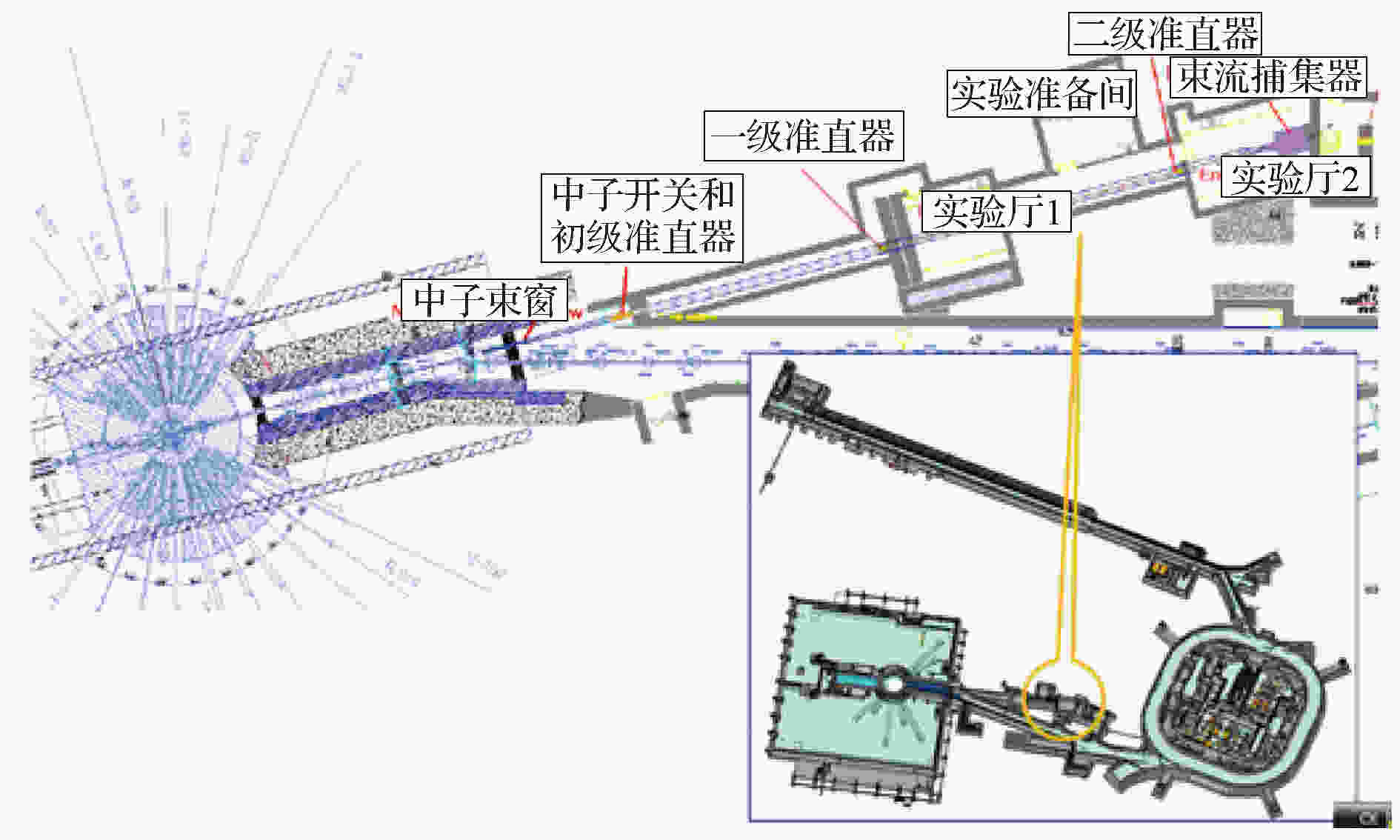 图 1 CSNS装置布局及其反角白光中子源
图 1 CSNS装置布局及其反角白光中子源Figure1. Arrangement of back-streaming neutron beam at CSNS
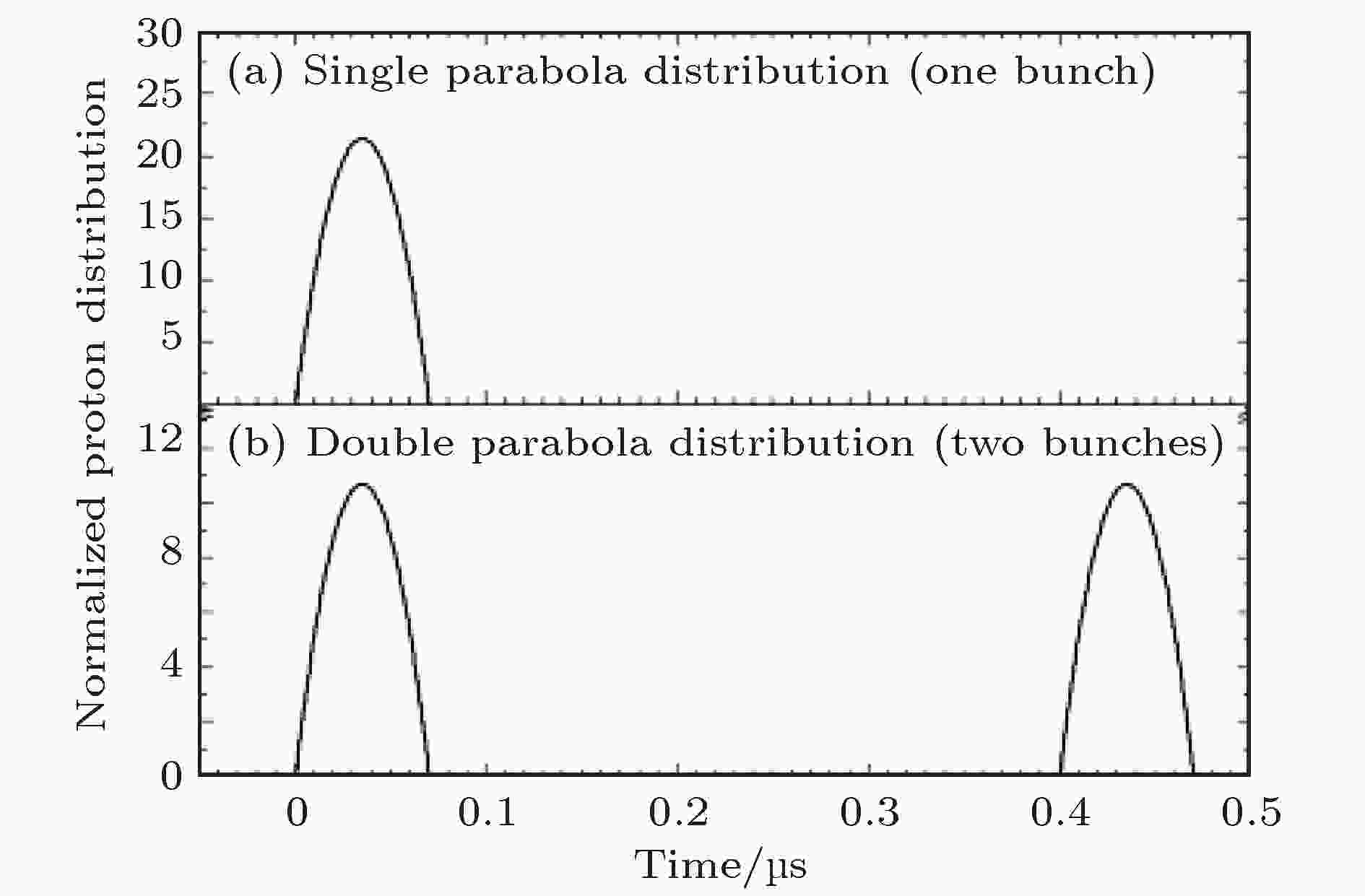 图 2 一个脉冲内的两种供束模式
图 2 一个脉冲内的两种供束模式Figure2. Two kinds of operation modes.
对于双束团模式, 单个束团的半高宽约50 ns, 两束团之间的距离约410 ns. 在要求高时间(即能量)分辨的物理实验中, 最好采用单束团进行实验, 如果采用双束团进行实验, 则需要对测量结果进行解谱分析.
2)中子能量区间宽. 入射能量为1.6 GeV的质子束打在钨靶上产生的散裂中子能谱可通过蒙特卡罗模拟计算得到. 图3给出了束流功率为100 kW时, 反角方向75.8 m远处的能谱. 可以看出, 中子的能量区间很宽, 低至热能, 高至几百MeV; 而且高能中子成分还相当丰富. 考虑到在物理实验中需采用飞行时间法(TOF), 而脉冲束周期只有40 ms (对应于脉冲束频率25 Hz)的实际情况, 在测量中必须将热中子以及更低能量的中子去掉(其飞行75.8 m所需的时间已接近或超过40 ms). 由于镉(Cd)对热中子有很高的截面, 形成切割效应, 这里是采用在中子束线上游前端放置镉片的方法实现的.
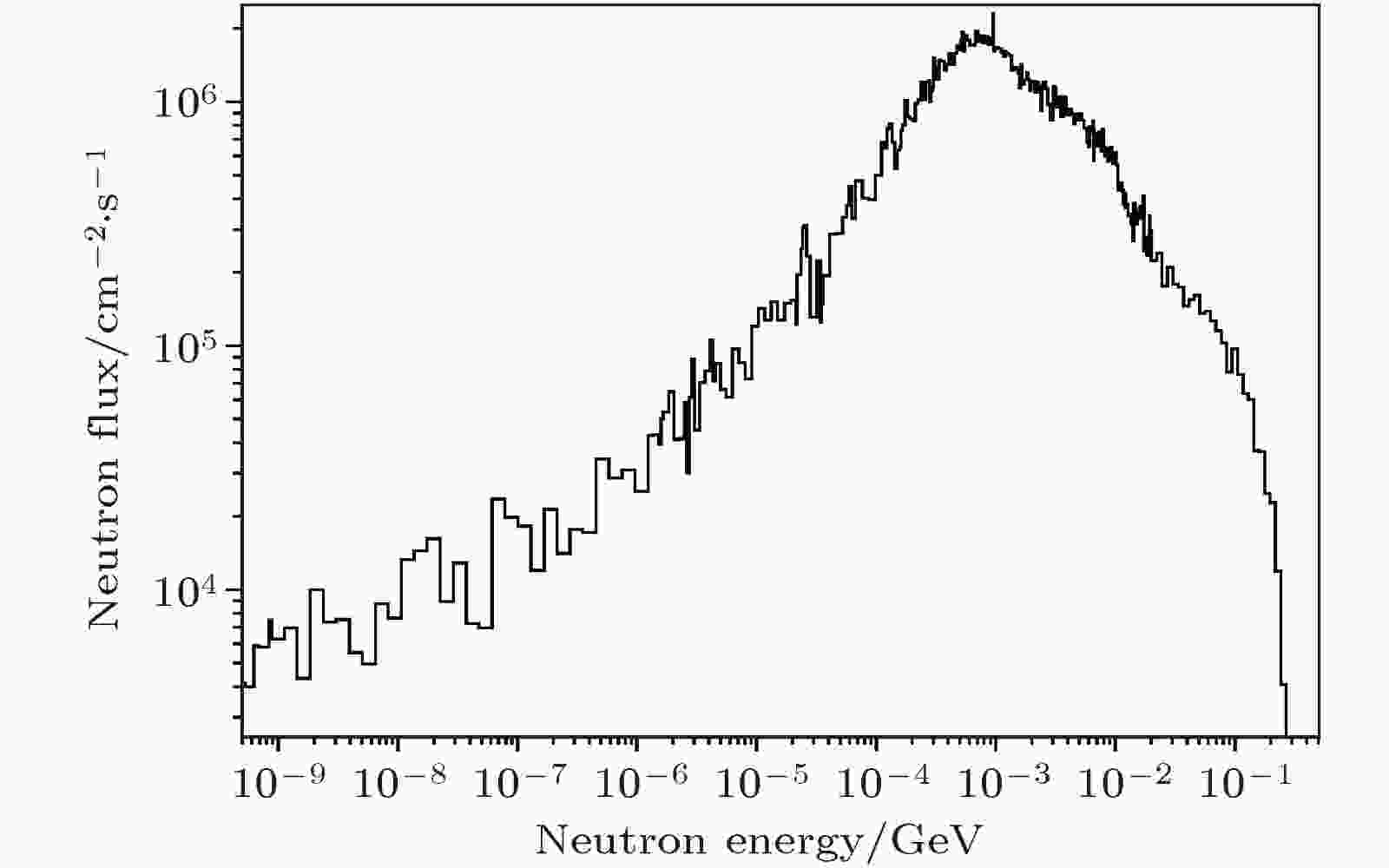 图 3 蒙特卡罗模拟得到的反角出射的散裂中子能谱
图 3 蒙特卡罗模拟得到的反角出射的散裂中子能谱Figure3. Stimulated neutron energy spectrum of back-streaming beam.
3)每个质子脉冲产生的γ射线强度高时间短. 模拟计算表明每个脉冲内伴随散裂反应产生的γ射线与散裂中子产额比约1∶2.3. 由于产生的中子能量分布很宽, 因而飞行一段距离后分布在很宽的时间段内, 对探测器来讲有足够的响应时间利于测量; 而对伴生的瞬发γ射线, 无论其能量高低都以光速行进, 因此集中在与质子束团相当的时间范围内(每个约50 ns). 若用探测器在实验厅进行测量, 则在约50 ns的时间间隔内就有大于106的γ射线入射到探测器上, 称之为“γ闪光”(γ-flash), 它使探测器饱和甚至阻塞, 影响后续事件的记录, 在测量中必须想法消除“γ闪光”造成的影响. 上述束流特点有别于以往经验, 对实验测量提出新要求, 下文具体实验描述中都会有体现.
2
3.1.中子能谱和注量率测量
33.1.1.高能能区的中子能谱和注量率测量
1)实验装置中子能谱和注量率测量系统的探测器为多层(5层)快裂变室[17-20], 如图4所示. 多层快裂变室内部是高纯度的235U和238U靶片, 镀层平均厚度约

 图 4 多层快裂变室
图 4 多层快裂变室Figure4. The multi layer fission chamber.
探测器时间分辨和粒子分辨是对重要并需要兼容的指标, 初步选定极间距10 mm, 实验上可以有效分辨α粒子和裂变信号, 系统时间分辨好于35 ns.
探测器信号通过同轴电缆接入前置放大器和成形放大器, 然后进入读出电子学系统. 前置放大器使用Mesytec公司的MSI-8集成放大器, 它是一款紧凑型8通道成形放大器, 且具有集成的定时滤波放大功能. 由于模块化的设置, 每个通道可以单独选择前置放大和成形模块的类型, MSI-8可同时输入8路信号, 每路输入信号对应T(时间)和E(能量)两个输出信号, 如图5所示, 其中负信号为T信号, 正信号为E信号. T信号的上升时间约70 ns, 通过恒比定时可以得到好于20 ns的定时精度, 满足测量反角白光中子源的10 MeV以下中子的飞行时间的需求.
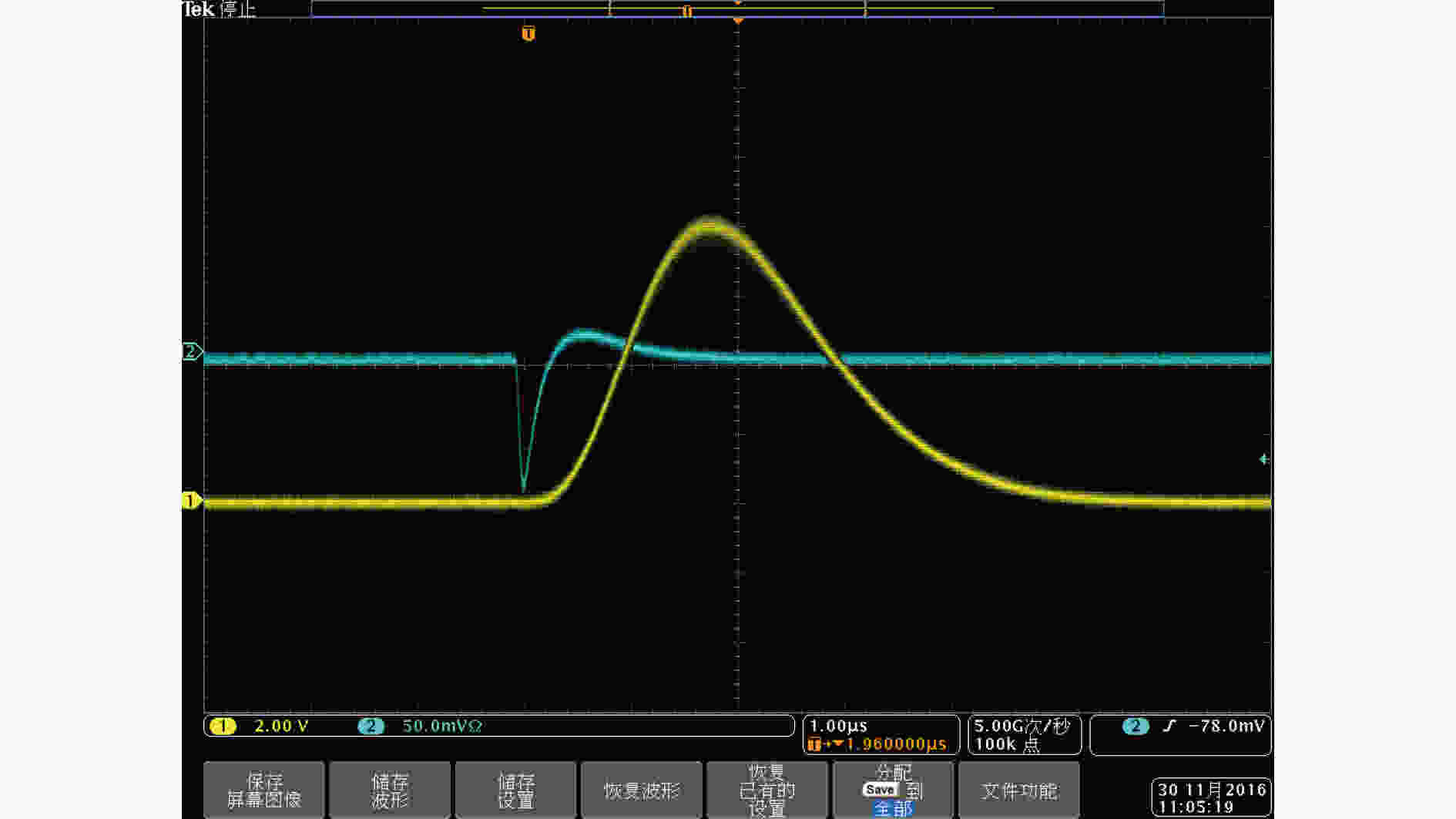 图 5 MSI-8的输出信号
图 5 MSI-8的输出信号Figure5. The output signal of MSI-8 module.
图6是多层快裂变室的实验测量时间信号, 左侧两个相隔较近的小信号就是两个束团的γ-flash, 右侧较大的信号是裂变碎片的信号. 通过分析不同的信号发现, 裂变碎片的能量信号和时间信号幅度都很大, α粒子的能量信号和时间信号幅度都较小, 而γ-flash的能量信号很大, 时间信号远小于裂变信号. 根据这一特征, 可以比较容易区分信号的类型.
 图 6 裂变室的时间信号
图 6 裂变室的时间信号Figure6. The time signal of the fission chamber.
2)实验测量
能谱测量主要在实验厅-2进行, 采用单束团模式, 束流功率15 kW左右. 中子注量率测量采用相同的裂变电离室, 只是将其中的靶片换成了精确定量的两片235U和两片238U, 其定量精度为1.5%, 注量率测量实验时的加速器运行参数与能谱测量基本相同.
裂变室的五个靶片对应五路输出信号, 这五路信号进入成形放大器MSI-8, MSI-8分别处理每一路信号, 并输出能量信号E和时间信号T. 通过调节MSI-8的增益, 可使E信号幅度为0—400 mV, 而T信号的信号幅度在–1500—0 mV之间. 把E信号和T信号通过数据获取系统的调理电路板(SCM板)后再接入波形数字化采集卡(FDM板), 通过DAQ软件就可以获取波形数据. 整个数据获取系统采用外部触发方式, 触发源是质子束流的脉冲拾取信号, 这样探测器测得的信号就和质子打靶有了严格的一一对应关系, 保证了中子飞行时间的精度.
3)数据处理和实验结果
数据处理的思路是: 根据所获取的裂变碎片的波形数据, 确定有效信号及其过零时刻; 确定该有效信号的中子飞行距离和飞行时间; 得到中子飞行时间谱(即裂变率谱); 进行探测效率修正得到中子能谱等四个步骤.
a) 有效信号过零时刻的确定. 根据原始数据的存储结构, 把每个周期内(FCT给出)的有效信号通过过阈触发, 按时间顺序排列; 之后通过滑动滤波(多点平均)得到光滑的有效裂变信号; 再通过微分方法, 并作光滑处理和拟合处理, 得到过零点. 图7是得到有效信号过零点的一个具体实例.
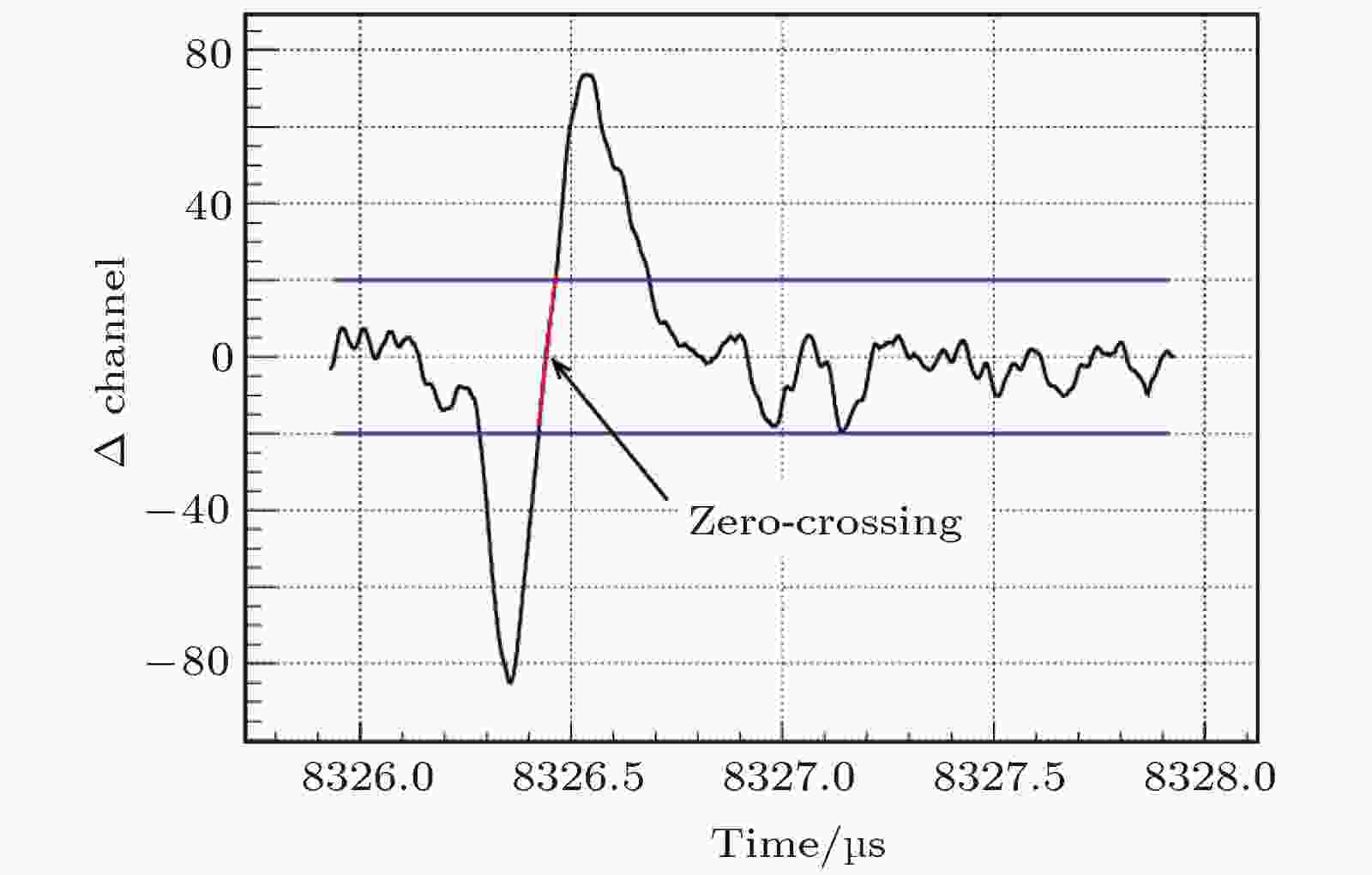 图 7 过零定时效果示意
图 7 过零定时效果示意Figure7. Zero-crossing time determination of signal.
b)中子的飞行距离和飞行时间的确定. 根据实验测量到的探测器介质的特征共振峰位及其与标准截面库给出的该特征共振峰位的比较, 确定中子飞行距离. 再通过散裂反应γ脉冲和裂变碎片脉冲(即中子到达时刻)的相对位置确定中子的飞行时间(图8). 中子飞行时间等于γ脉冲和中子到达时刻之间的时间差与L/c之和(其中c是光速, L是探测器到散裂靶的距离).
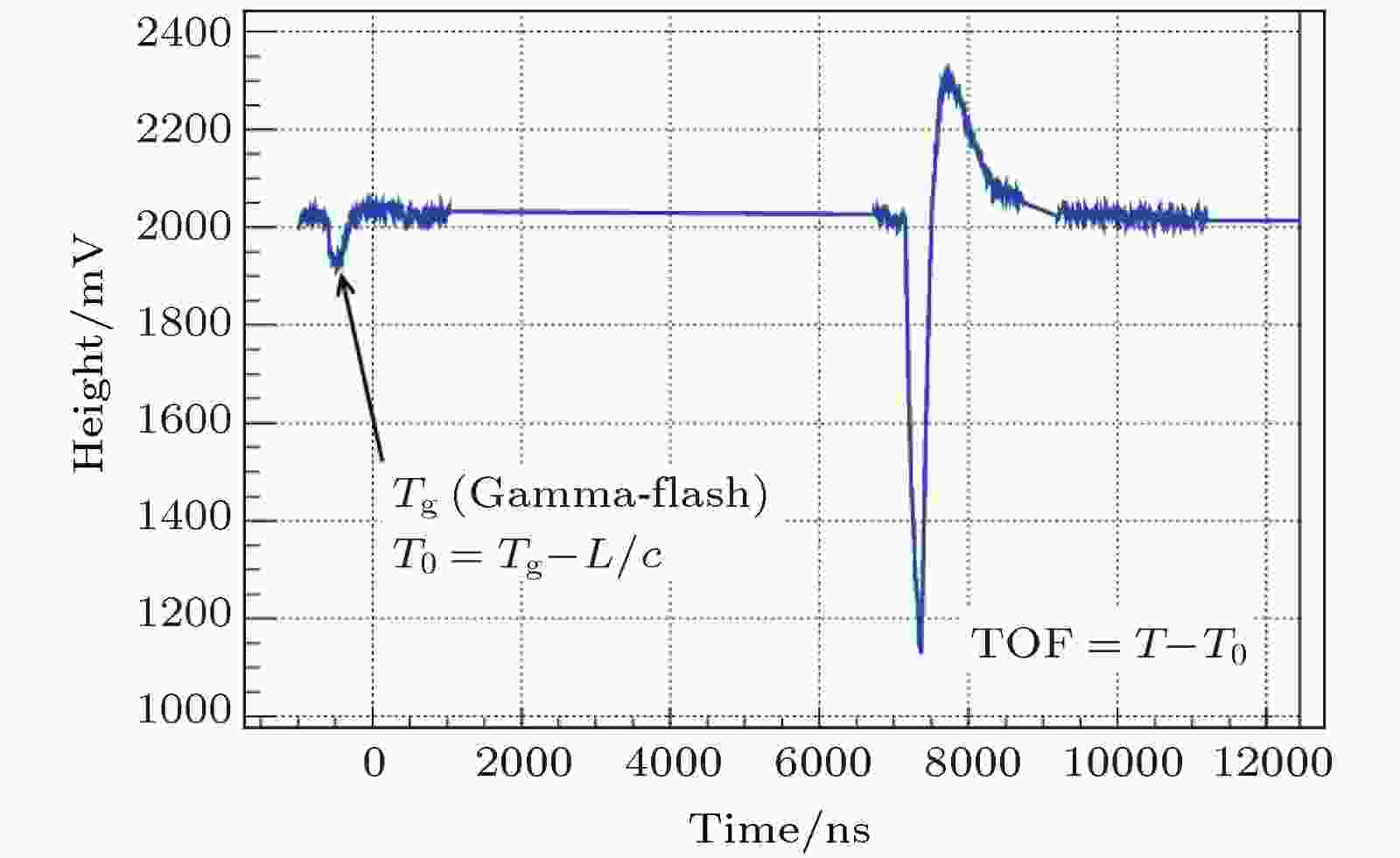 图 8 有效裂变信号的飞行时间确定示意图
图 8 有效裂变信号的飞行时间确定示意图Figure8. Time determination from fission signal.
c)中子飞行时间谱(即裂变率谱)的获得. 每一个周期内的有效信号(即裂变碎片信号)与中子起飞时刻之差即为中子的飞行时间. 记录中子数目随中子飞行时间的变化即得到中子飞行时间谱, 即裂变事件率的时间谱, 如图9所示.
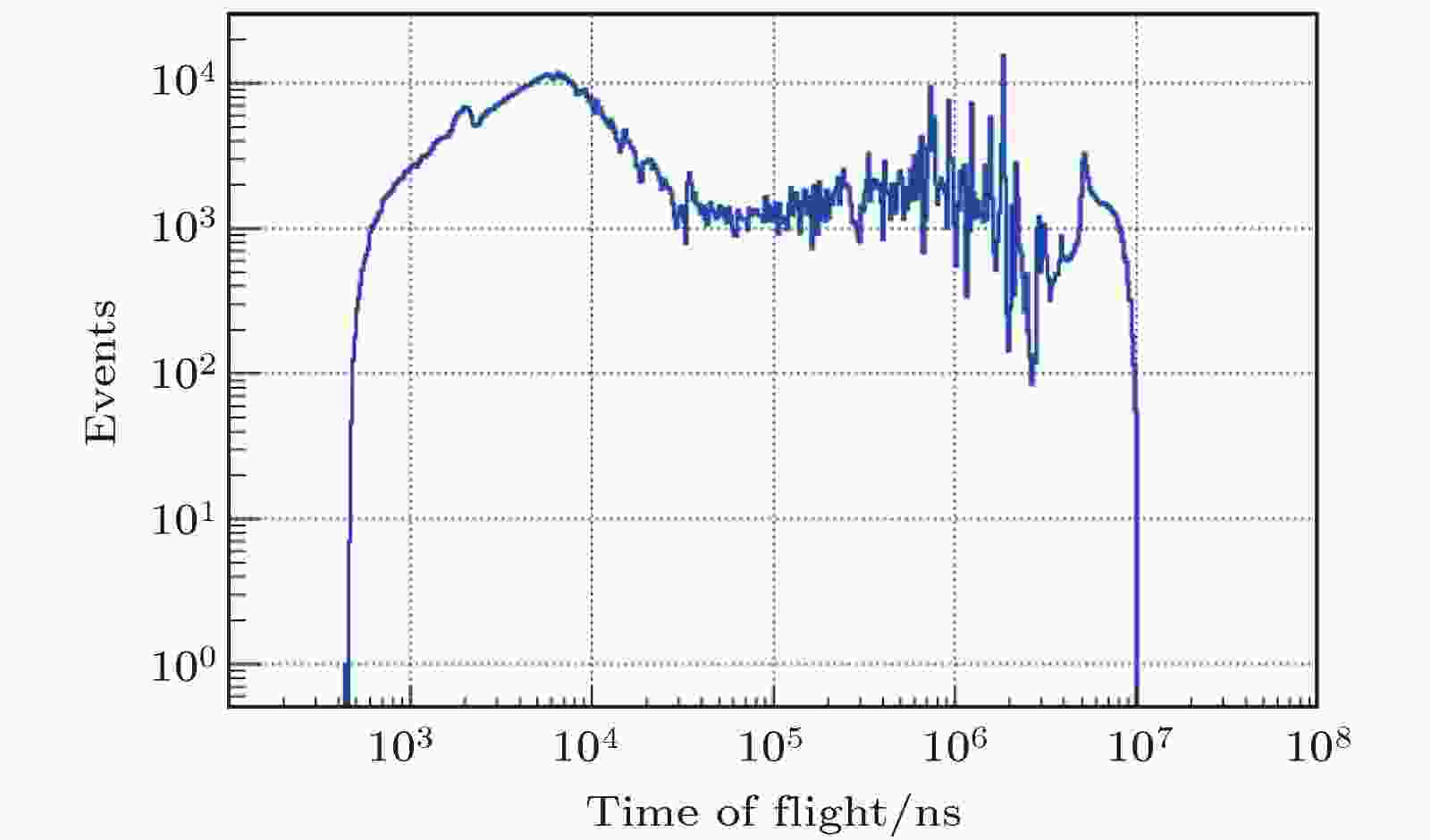 图 9 中子飞行时间谱
图 9 中子飞行时间谱Figure9. Neutron time-of-flight spectrum.
d)中子能谱和注量的数据处理过程. 中子能谱根据下面公式得到:
3
3.1.2.低能区间的中子能谱和注量率测量
低能能区的中子能谱和注量率是用6LiF探测器和235U裂变室测量的. 由于在低能区间235U的裂变截面存在共振, 按照国际原子能机构(IAEA)推荐的标准截面数据在低能量区间, 6Li (n, ɑ)T反应产生的两个带电粒子的能量较大(4.8 MeV), 很容易测量, 截面值平滑, 在低能区间将以含6Li探测器的测量为主. 6LiF探测器的结构如图10所示, 将6LiF电镀到铝膜上制成转换靶, 6LiF厚度约200 μg/cm2, 电镀区直径60 mm, 底衬铝膜厚约10 μm (模拟表明对全能区中子注量率的影响不到万分之一). 离6LiF镀层轴心线上外部约30 mm处平面上, 对称放置8个金硅面垒型探测器, 用于测量反应带电粒子, 同时保证探测器不在中子束线内. 每个探测器灵敏面积20 mm × 20 mm, 每个探测器的过中心法线通过6LiF靶的中心. 中子同6Li反应产生的带电粒子将被探测器记录, 由此得到低能区中子的能谱和注量率.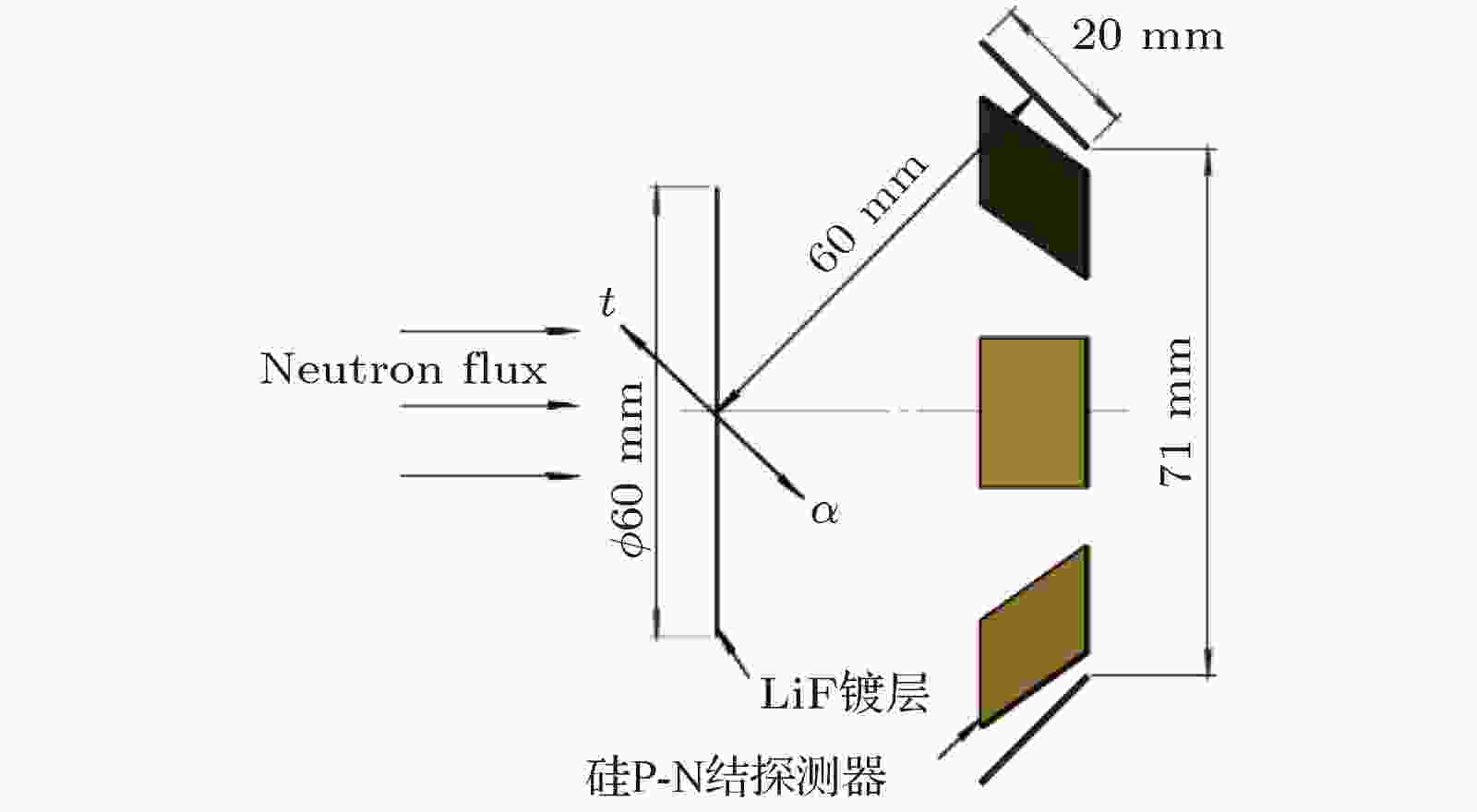 图 10 6Li-Si 探测器结构
图 10 6Li-Si 探测器结构Figure10. 6Li-Si Detector structure.
6Li-Si探测器测量中子能谱和注量率的过程与上节裂变室的测量类似, 这里不再赘述.
用 6Li-Si探测器测量中子能谱和注量率如图11中的黑方块所示, 其能区覆盖范围从eV至200 keV. 圆圈代表用235U裂变室测得的结果, 覆盖0.15 MeV以上能区, 但在低能区, 特别是2 keV以下, 存在共振. 黑圆点代表用238U裂变室测得的结果, 覆盖1.1 MeV以上能区. 整个中子能谱与实验前的模拟计算结果基本一致.
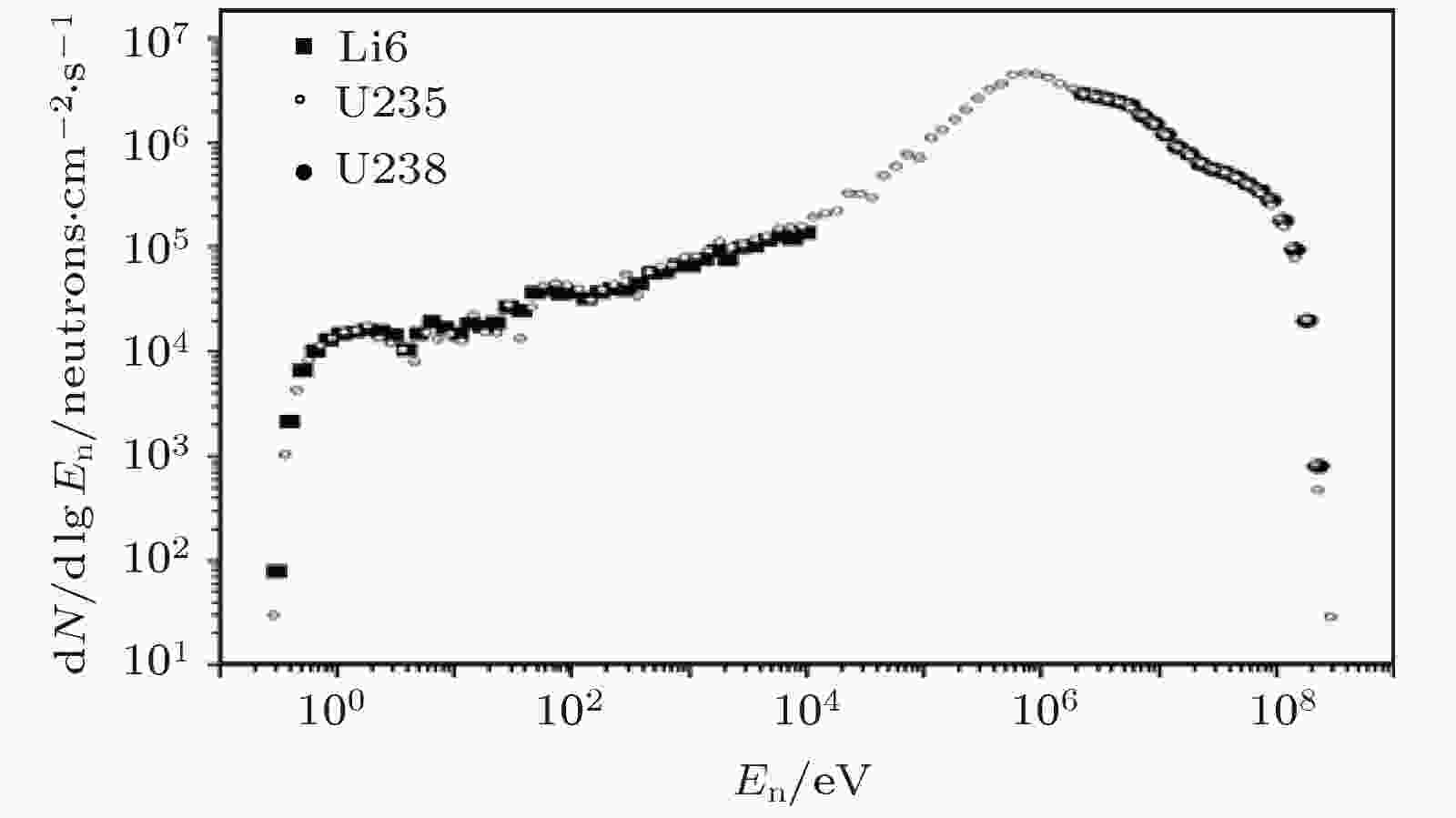 图 11 实验测得的CSNS 反角白光中子能谱
图 11 实验测得的CSNS 反角白光中子能谱Figure11. Experimental result of back-streaming white neutron energy spectrum.
根据中子能谱, 结合质子束流值和功率, 得到实验厅-1 (距离散裂中子靶站55 m) 在100 kW满功率运行时的中子注量率为1.75×107 s–1·cm–2, 实验厅-2 (距离散裂中子靶站75.8 m)在100 kW满功率运行时的中子注量率为7.03 × 106 s–1·cm–2, 不确定度约为3%, 两个测量厅的不确定度会有少许变化, 主要因为中子束斑和能谱上的微小变化.
2
3.2.束流剖面测量
33.2.1.中子束流剖面测量装置及工作原理
束流剖面测量采用闪烁体 + 反射镜 + 相机的方式, 测量装置示意图如图12所示.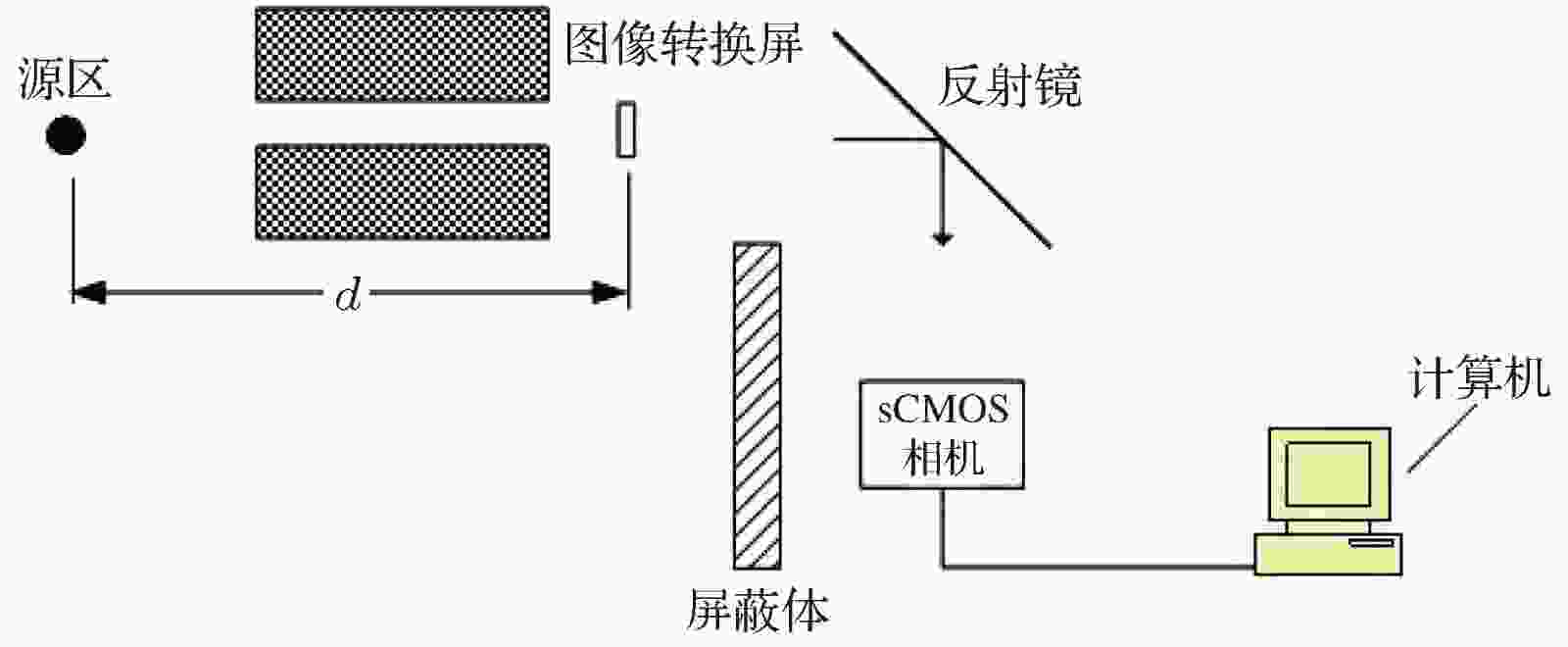 图 12 中子束剖面测量装置
图 12 中子束剖面测量装置Figure12. Neutron profile measurement equipment.
辐射图像转换屏采用了两种类型的闪烁体: 一种是?150 mm × 10 mm的EJ-230塑料闪烁体, 主要对快中子响应; 另一种为6LiF/ZnS的闪烁屏(EJ-426HD2, 6LiF∶ZnS为1∶2, 厚度为0.32 mm), 主要对低能中子响应.
探测器的光电转换器件和数据采集部分采用的是ANDOR-ISTAR-sCMOS相机, 其基本参数为: 像素阵列2560 × 2160, 像素大小6.5 μm, 全幅最大帧频率50, 门控时间 < 5 ns, 制冷温度0 ℃. 镜头为Nikon 50 mm 1/1.8. 反射镜厚度2 mm. 测量中, 采用Integrate On Chip模式, 经多个脉冲采集后在芯片上累加一次读出, 可大大降低读出噪声.
实验时需如图13所示. 触发信号由每个周期的触发信号提供, 相机延迟采用内部延迟, 结合相机的延迟时间以及门宽来进行中子飞行时间的选通, 从而选择不同的中子能量段作剖面测量.
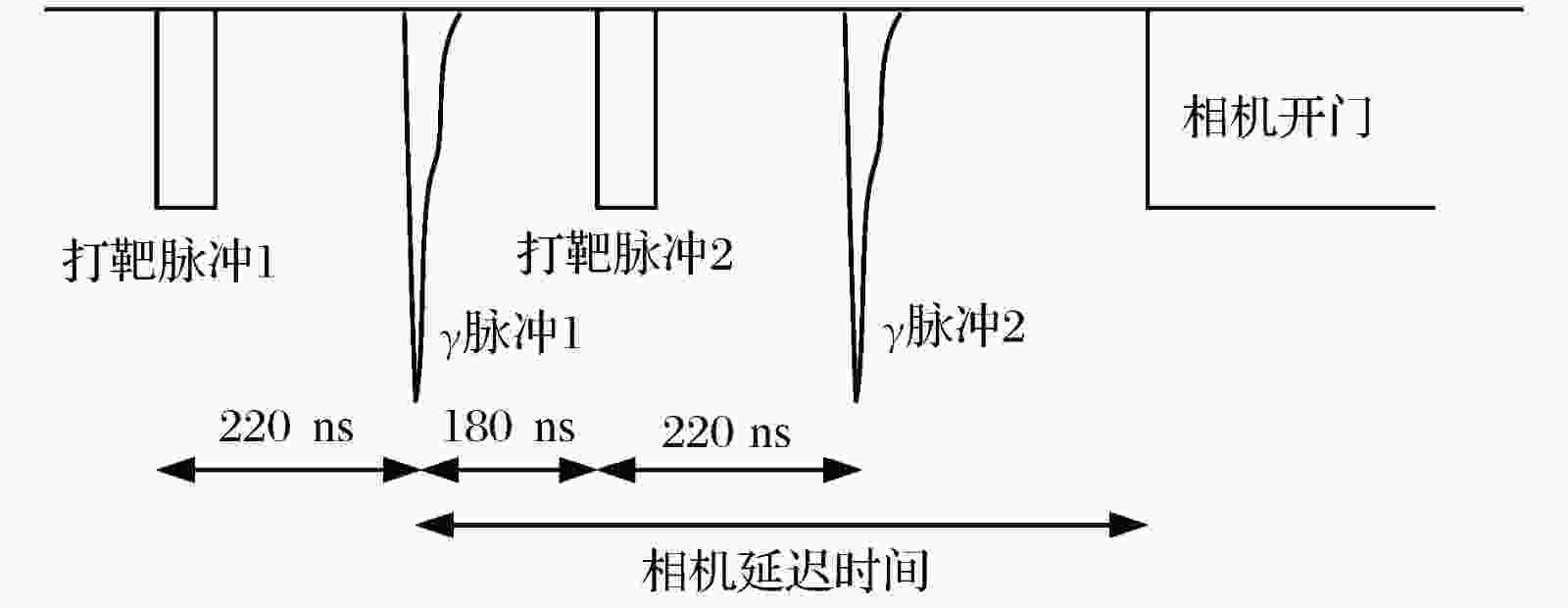 图 13 探测器触发时间关系
图 13 探测器触发时间关系Figure13. Timing-serial of neutron profile detection.
3
3.2.2.中子束流剖面测量的数据处理和结果
图像处理内容包括图像预处理、系统性能标定和束流剖面判定尺寸判读等环节. 图像预处理包括: 尺寸标定、γ斑点(亮白点)去除和本底扣减等内容. 在此基础上分别完成了中子束剖面轮廓判定及尺寸判读、系统调制传递函数测量和中子能谱测量的初步分析. 系统性能标定主要指系统的空间分辨能力, 本实验中通过厚刀口法测量得到探测系统的调制传递函数, 从而得到系统空间分辨能力, 并利用狭缝法验证. 束流剖面判定尺寸判读基于Hough变换的圆检测算法, 得到不同能量对束流轮廓、尺寸的影响, 不同能量不同计数圈内非均匀性变化规律, 束剖面轮廓中心与“重心”偏差分析等结果.对中子束轮廓判断、尺寸大小和均匀性进行了评估和定量分析, 并对中子重点能区的能谱(0.1—20.0 MeV)进行了初步实验研究. 在束斑直径理论值为Φ50 mm的实验厅-1 (距中子靶55 m), 实验测得的半高值(FWHM)对应的中子束斑值为Φ55 mm, 峰值强度约75%时对应的束斑直径为Φ50 mm, 与理论值一致. 在束斑直径理论值为Φ60 mm的实验厅-2 (距中子靶75.8 m), 实验测得的半高值(FWHM)对应的中子束斑值为Φ63 mm, 峰值强度75%时对应的束斑直径为Φ60 mm, 也与理论值一致. 进一步分析表明, 束斑的轮廓尺寸与中子能量无关, 这说明各种能量的中子在束斑内是均匀分布的, 中子束强度在已判定轮廓的80%范围内不均匀性小于10%, 且束剖面不均匀性与能量无关. 剖面上的全能区中子束强度分布图及其在x轴方向和y方向的投影如图14所示.
 图 14 中子束斑剖面分布及其在x轴和y轴上的灰度值分布
图 14 中子束斑剖面分布及其在x轴和y轴上的灰度值分布Figure14. Neutron profile distribution and grey scale information on x and y axis
束斑剖面的测量结果符合事先模拟计算[7]的结果(图15), 在束晕直径和灰度值分布上模拟和实验一致.
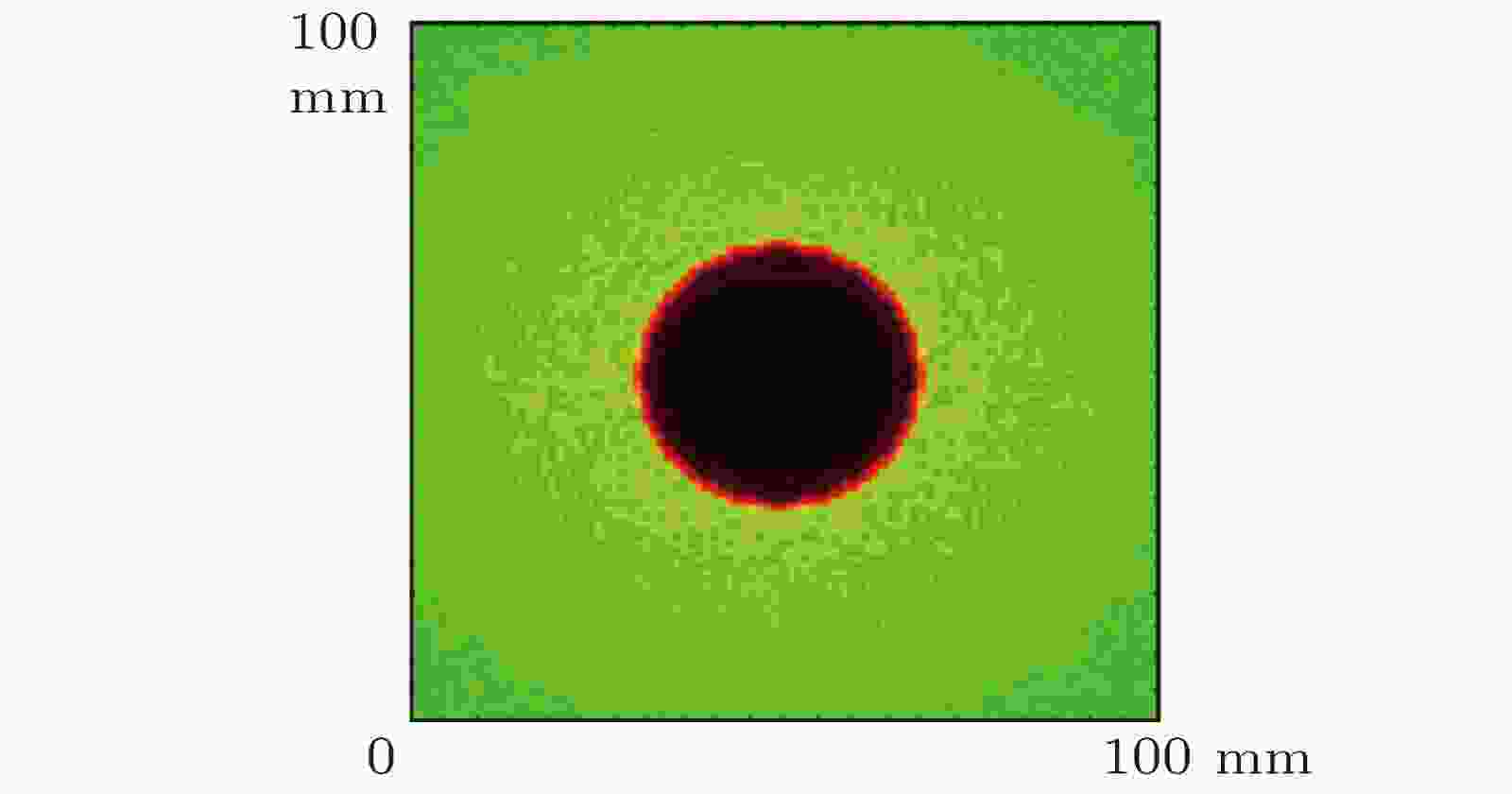 图 15 60 mm直径束斑模拟
图 15 60 mm直径束斑模拟Figure15. Simulation of neutron profile in 60 mm diameter.
实验准备和测量过程中, 感谢中国原子能科学研究院的唐洪庆和周祖英两位老师的悉心指导, 感谢探测器标定过程中加速器组提供的优质束流, 感谢散裂中子源值班人员放弃春节假期坚守岗位.
